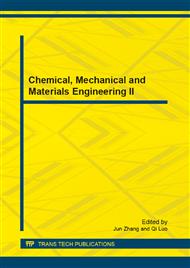p.54
p.58
p.62
p.66
p.73
p.79
p.84
p.90
p.96
Study on the Properties of CrN Coating Prepared on 3Cr2W8V by Electron Beam Surface Alloying Process
Abstract:
CrN coating was deposited on 3Cr2W8V alloy by PVD and then processed with electron beam surface alloying process. The pulsed times of HCPEB was changed from 1 to 25 to prepare different specimens. Microstructures were investigated by optical metallurgical microscopy (OM), results show that the particles located in surface layer were obviously refined and the thickness of coating film has important influence to surface alloying . When the coating film is very thick, the heat-affect areas which are made by electron beam do not influence the matrix a lot. Microhardness, friction coefficient, amount of wear of electron beam treated specimens were determined. It is shown that the coating has an average microhardness of approximately HV630, the friction coefficient of electron beam irradiation treated specimens is considerably lower than that of CrN coating. When the electron beam irradiate times is appropriate, the roughness of surface will much lower, and it will achieve polishing effects. The corrosion behavior of the composite coating in 3.5% NaCl solution at room temperature was also determined using a potentiont state system. By comparing the electron beam treated specimen of 3Cr2W8V alloy to that of the primary 3Cr2W8V dendrites, the corrosion potentials of CrN coating and electron beam treated specimen are increased respectively. The electron beam treated specimen has the lowest corrosion current density as well as the highest corrosion potential showing an improved corrosion resistance compared with 3Cr2W8V alloy.
Info:
Periodical:
Pages:
73-78
Citation:
Online since:
May 2013
Authors:
Keywords:
Price:
Сopyright:
© 2013 Trans Tech Publications Ltd. All Rights Reserved
Share:
Citation:


